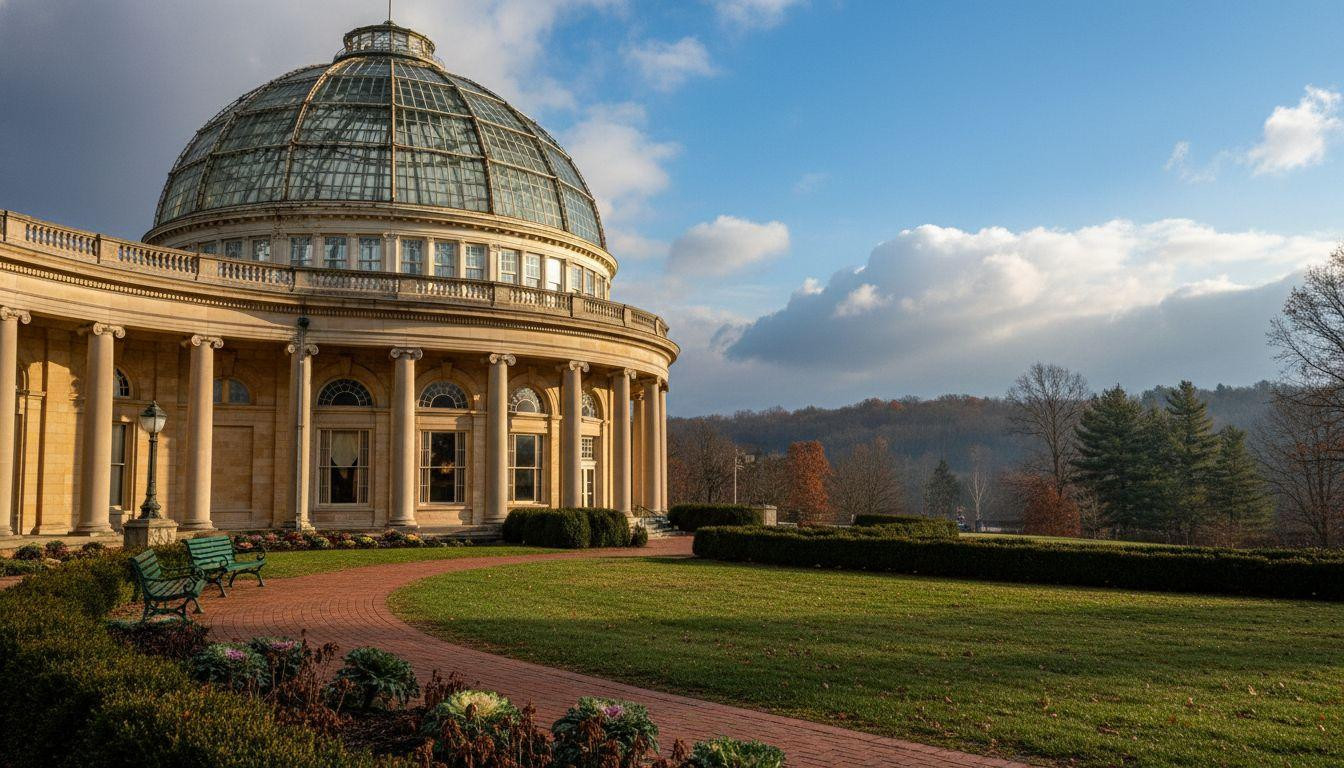Dawn breaks over French Lick at 6:47 AM, casting golden light through the 200-foot glass dome of West Baden Springs Hotel. Steam rises from mineral springs that have bubbled unchanged for centuries. Just 1,800 residents call this southern Indiana town home, yet it preserves Gilded Age grandeur that rivals European spa resorts at a fraction of the cost.
Ninety-five miles from Indianapolis, French Lick exists in that rare space where architectural impossibility meets small-town authenticity. The West Baden dome, once called the “Eighth Wonder of the World,” anchors a National Historic District where honey-colored sandstone glows against forested hills.
Where America’s forgotten spa culture still breathes
French Lick sits at 650 feet elevation in Orange County’s rolling countryside, surrounded by 200,000 acres of Hoosier National Forest. The town occupies just 8.8% of the county’s population, creating an intimate community where everyone knows everyone.
Two grand hotels face each other across manicured lawns: French Lick Springs Hotel (1901) and West Baden Springs Hotel (1902). Both showcase Beaux-Arts architecture with Renaissance Revival details that transport visitors to Europe’s golden age of spa culture.
The mineral springs that built this empire still flow at 68°F year-round. Native Americans considered these sulfur-rich waters sacred for 500 years before European settlers arrived in the 1840s. Like historic Norman villages, French Lick preserves authentic heritage without commercial overlay.
Architecture that defied the possible
The 200-foot glass cathedral that shouldn’t exist
West Baden’s atrium stops visitors mid-step. Six stories of curved glass and steel rise impossibly above Italian marble floors, creating acoustics where whispers travel 75 feet to upper balconies.
Built in 1902 with a $414,000 budget and one-year timeline, the dome held the world’s largest free-span record until 1913. Morning light creates golden columns through the skylight, illuminating carved woodwork unchanged since Theodore Roosevelt’s era.
Beaux-Arts beauty in small-town scale
French Lick Springs Hotel spreads its Renaissance Revival facade across 5 acres, complemented by period furnishings and original fixtures. Unlike commercialized resort towns, preservation here feels authentic. No luxury brand overlays, no theme park polish.
The National Register listing ensures architectural integrity while allowing modern spa amenities to blend discreetly. Walking the colonnade at sunset, when sandstone glows amber against darkening hills, delivers European grand hotel atmosphere at one-third Saratoga Springs costs.
Wellness culture unchanged since 1840
Mineral baths and championship golf
Spa treatments center on original mineral springs with 1,200 ppm sulfur content. The historic plunge pool measures 25 by 15 feet, maintained at 98°F in original 1910 tile. Modern facilities incorporate 19th-century hydrotherapy with contemporary massage techniques.
Donald Ross designed the historic golf course in 1917, recently restored to original specifications. The Pete Dye championship layout hosted the 2015 KitchenAid Senior PGA Championship. Green fees range $125-$225, delivering PGA-level play at municipal course prices. Similar to preserved colonial towns, authenticity trumps commercialization.
Steam trains and forest solitude
French Lick Scenic Railway carries passengers through Hoosier National Forest on vintage 1940s trains. The 6.5-mile journey winds through three distinct ecosystems, with naturalist commentary and seasonal specialties like Polar Express rides beginning November 29.
Ticket prices range $35-$95 depending on service level. Hiking trails connect limestone caves and Blue River overlooks, offering solitude impossible at commercialized national parks. Like European spa towns, the pace remains unhurried and healing-focused.
The Europe you can actually afford
Standing beneath the West Baden dome at golden hour, comparing it to European train stations and spa resorts, the economics become clear. This architectural grandeur costs $150-$250 per night versus $400+ in Baden-Baden or Vichy.
The unhurried atmosphere, local hospitality, and authentic preservation create something Saratoga Springs lost to commercialization. French Lick offers 32% below national average costs while maintaining upscale amenities. Recent visitor surveys show 287,000 annual guests, compared to Saratoga’s millions.
This represents American resort culture before corporate homogenization. Still healing, still gracious, still accessible. Like undiscovered nature sanctuaries, French Lick rewards those who venture beyond obvious choices.
Your questions about French Lick, Indiana answered
How do I get there and what does it cost?
Drive from Indianapolis (95 miles, 1 hour 45 minutes), Louisville (90 miles, 1.5 hours), or fly into regional airports. Accommodation ranges $139-$179 at local inns to $249-$349 at historic resort hotels. Spa treatments cost $95-$185, golf $125-$225, scenic railway $35-$95.
What makes the local food culture special?
Midwestern comfort cuisine dominates with pork tenderloin sandwiches, Hoosier sugar cream pie, and Indiana wines. Resort restaurants offer fine dining steakhouses with German influences reflecting regional heritage. The unhurried meal pace matches the town’s wellness atmosphere.
How does it compare to other historic spa towns?
French Lick preserves similar Gilded Age heritage as Saratoga Springs at 35% lower accommodation costs and 40% fewer crowds. Annual visitors total 287,000 versus Saratoga’s 1.2 million. Architecture rivals eastern resorts while Indiana location maintains authentic small-town hospitality.
At 4:58 PM, November sun angles through the West Baden dome, casting geometric patterns across marble floors. Steam rises from mineral pools while vintage trains whistle through autumn forest. This is American wellness culture before it became an industry.
